HFA Audio Setup History 30 – Speakers and Amps – April 2018/Aug 2018
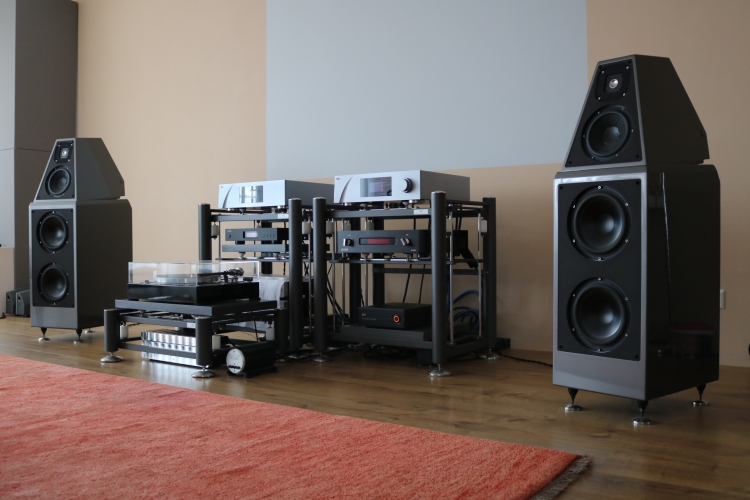
Finding my next reference speakers and amplifiers – part 3
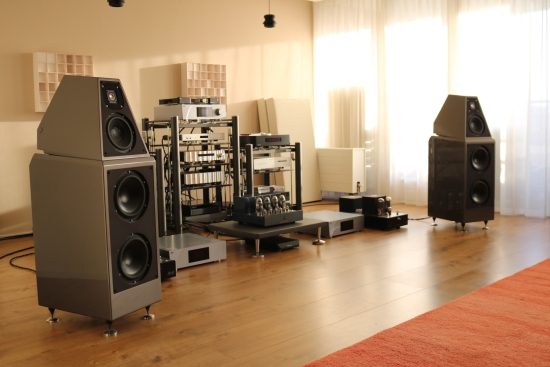
CH + Wilson Watt/Puppy 8
After the superb results using the CH equipment with the Logans, it was now time to see how they performed with my own Wilsons. But before going full out, first I switched back to my last known Wilsons setting using the very cost-effective 3375 euro PrimaLuna DiaLogue Premium tube amp that has been functioning as my default go-to amp while I am making up my mind as to which amp works best with the Wilsons. Naturally, it first took some acclimatizing to switch from the transparent and refined Logans to inevitably more colored “cabinet” speakers. Indeed the first evening when switching I could not get comfortable with the Wilsons quite so easily. As open and neutral as the Wilsons seem, they still sound quite uneven compared with the Logans. By comparison, the Wilsons’ frequency range seems to go all over the place.
As could be expected, the humble PrimaLuna DiaLogue Premium with KT150s could not keep up with the CH Precision A1’s, especially in terms of refinement, resolution, evenness, and transparency, but it still turned in a lively and enjoyable presentation, once you have gotten used to its rougher presentation. This is the remarkable thing with tubes: even if they don’t perform anywhere near as well on the usual audiophile individual aspects, still, they can possess a certain magic and engagement factor. Then again, if one wants a tube amp to approach the A1’s incredible levels of neutrality, transparency, and refinement then considerable funds are required just the same.
However, when switching from the PrimaLuna to the CH Precision A1 amps, much of that unevenness was greatly reduced, not only in the bass, which was now tighter, deeper, and more articulate but also in the midrange and treble which became more polished and more well-mannered. So, while the Wilsons are no Logans in terms of evenness, understandably, the PrimaLuna also is no CH.
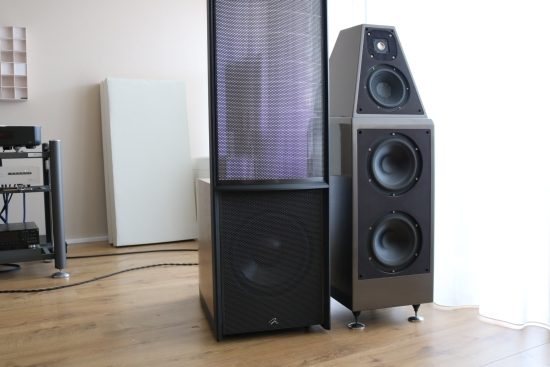
The Wilson looks almost compact, compared to the ESL15A… and’ we’re only still seeing half of the latter!
After some time though, my sensibility to this aspect yielded to the lure of the Wilsons’ more expressive and dynamic sound, and the next day I was no longer bothered by it. To me, this indicates that our hearing and the way that we listen to music is much more sensitive to shifts in loudness than to unevenness in the frequency range. Once I was used to the Wilsons’ more “characterful” sound, it occurred to me that this was actually the best bass that I had heard them produce so far! Tight, deep, articulate yet sonorous, and bold, it was just right! It has to be said: just like the Logans, the Wilsons also showed a remarkable synergy with these CH components.
Although Martin Logans are typically more immediate and dynamic than full-range magnetostatic dipoles such as Apogees, the Wilsons are more expressive still. For all their detail, immediacy, and transparency, the Logans are quite smooth and relaxed. By comparison with the super-dynamic Wilsons, they appear just a little restrained and it was mainly this aspect that pulled me further toward the Wilsons, rather than switching to ESL15A’s, in spite of their many benefits.
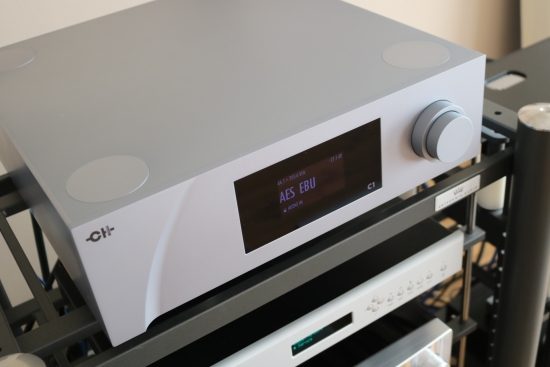
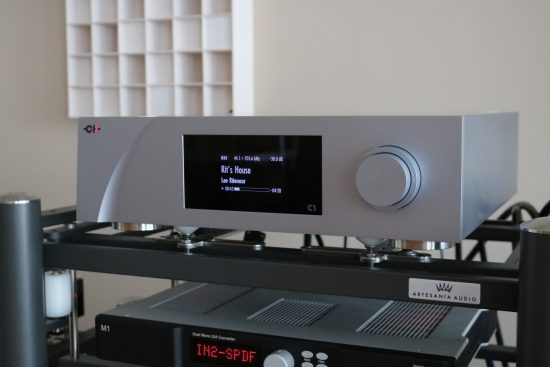
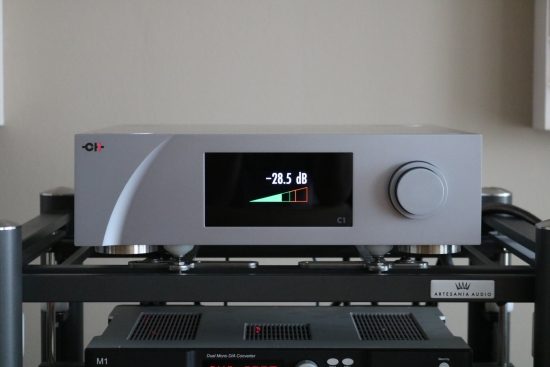
CH C1 DAC/Controller/Streaming endpoint
Regardless of the speakers used, I was already pretty much sold on the A1 amp. Then, I found that CH not only makes a spectacular amp, their DAC is also world-class, and I really did not see that coming. I’ve always been a fan of Wadia DACs, especially because of their superb bass performance and their lifelike midrange texture. Their lesser aspects include a dark tonality and less than fluid treble. These aspects became better and better as the brand released new models and the 521 DAC really was a very good compromise between the brand’s classic strengths and a more refined, more modern sound.
My latest reference DACs include the 10.000 euro Bricasti M1 (for a smoother, forgiving sound) and the Aqua Formula xHD (for the best transparency and a more neutral delivery). Both DACs are higher resolving and airier than the Wadia and although the Aqua also betters the 521 in terms of midrange purity and natural tonality, it does not quite have the Wadia’s bass heft or its big and sonorous presentation.
To make matters worse, the C1 also turned out to sound even better without a preamp, which means that my precious Rowland Corus + PSU no longer applied! The interesting thing is that cutting out the preamp during past efforts usually resulted in a more clearly defined bass and a purer, more direct sound, but the steps forward always came along with other steps backward. With Wadias in particular, the bass and dynamics are usually best without a preamp but this always comes at the expense of a dry and square-ish treble. There’s none of this however with the CH Precision C1. This DAC sounds utterly fluid, airy, refined, powerful, and yet colorful and sonorous, and even when it drives the power amps directly. And don’t get me started on its elevated performance when streaming via the CH UPnP app from a Melco server!
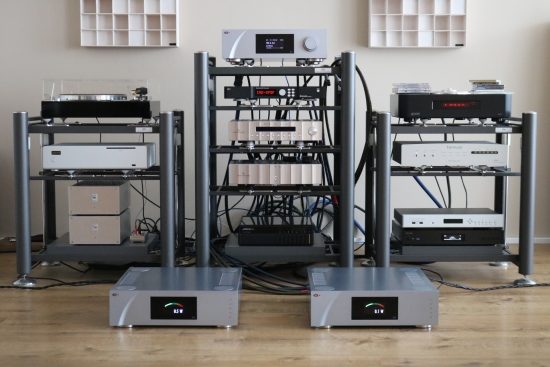
So now it appears that I needed to get not only a CH Precision amp but also a CH Precision DAC! These components cost an arm and a leg, a pact with the devil, and most of all a large loan but on the upside, these two components replace a whole array of components, and cables, and racks!
Read the CH Precision review
Read the Melco N1A2 and N1ZH review
Martin Logan Renaissance ESL15A Extensive review
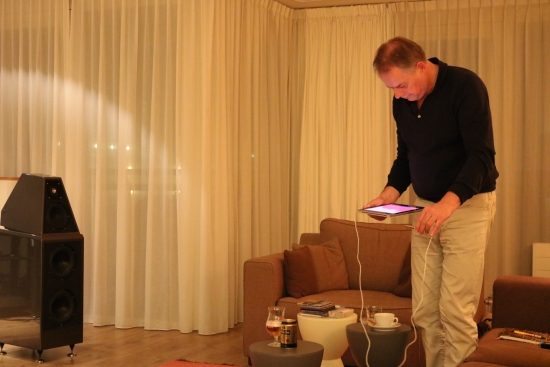
ACOUSTIC MATTERS
I never thought that I would ever need the help of a specialized company for optimizing my acoustics. What’s more, until a few years ago I did not even think that my room needed any treatment, other than the self-explanatory measures to avoid first reflections or reverb and flutter echoes. I was convinced that proper speaker positioning in a large enough room negated the need for acoustic treatments and thought that such treatments were really only advisable if you had an extraordinarily bad room, due to other issues that they can cause. This would turn out to be a misconception and slowly but surely I changed my mind.
The thing is that the large dipoles that I used (first Magnepans, then Apogees) respond very differently in a room than most dynamic speakers do. Especially Room Modes (Room Resonance Frequencies) were not an issue at all with the Apogee Divas, or at least not in a sonically detractive manner. With the Wilson Watt/Puppy 8’s, however, the modes really are excited to disturbing levels and I just could not get this right with positioning alone. This incurred the realization that speaker positioning is indeed paramount, but careful use of acoustical treatment is required to bring further improvements that cannot be obtained with speaker positioning alone.
With the thought of the Martin Logans and their fantastic bass still fresh in my mind, as a last-resort effort, I contacted Ben van Leliveld of AcousticMatters to ask if he could help me optimize the setup for the Wilsons. And if this would not pay off, I would change speakers. Ben was happy to oblige and so we planned two sessions during which the setup would be perfected.
It’s not that I had not tried to get rid of the resonances before, but even when using 10 pieces of GiK 244 Broadband Bass Traps I could only diminish the annoying peaks very slightly. As I would learn later, I needed very different bass traps.
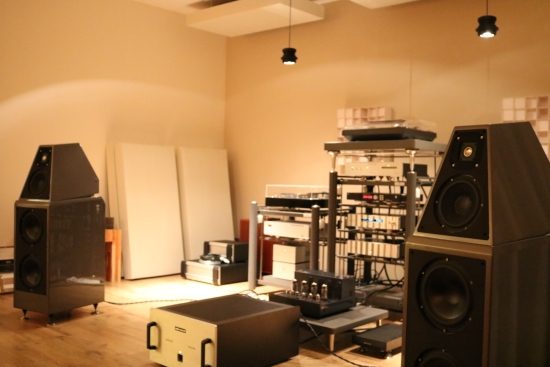
Above: speakers in their initial positions, with lots of Broadband bass traps behind them.
Measurements
The biggest surprise was not that I have multiple room modes, I was already aware of this, but that they are really quite severe! For example, using the Wilsons in the old setup, there’s a big dip below 100hz followed by a very big peak at 120hz and some more, smaller, peaks in several other places. The main peak was no less than 20dB higher than the average signal level. Remember: 6dB gives a doubling of the perceived level, so go figure! It was no wonder that I was unhappy with the bass performance.
After his first assessments, Ben commented that the speakers had been set up very precisely, but much further into the room than he thought to be ideal, and the listening position should be much more into the room. Naturally, I was aware of the theoretical ideal but this just did not work out in my room. And indeed, when Ben set up everything according to his beliefs, my bass problems were even worse. Adding an R.T.F.S. Big Block bass trap in each corner behind the speakers helped a lot, but more was needed.
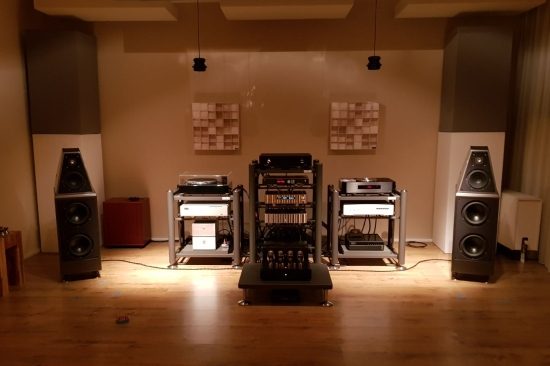
Double Big Blocks in each corner definitely further damped reverberated bass but still did not solve my problem entirely.
What I totally did not expect, however, was a huge step forward in imaging, as a result of Ben’s efforts. Not only was the focus and transparency now simply superb, but vocals were also truly lifelike and completely decoupled from the speaker enclosures, floating, no, make that hammered, freely in space. Timbre was already very convincing but had now improved massively as well, making for the absolutely most convincing natural piano- and percussion sounds that have ever heard before – in this room or anywhere else! I don’t use this term loosely, but the improvement in sound was simply spectacular!
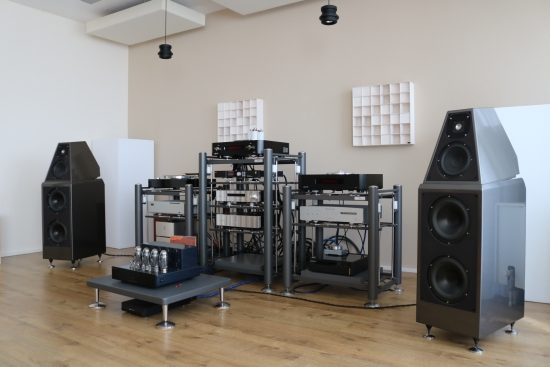
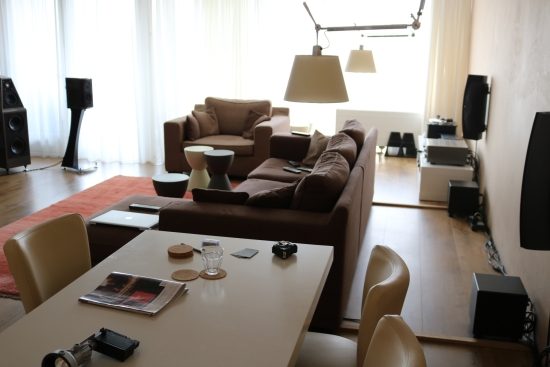
Above: sofa position after Ben’s second visit.
All that was needed now, per Ben’s prediction, were two more Big Block bass traps, totaling 4, divided between the 2 corners behind the speakers. Alas, when the extra Big Blocks arrived, it was clear that the improvement was not large enough. My bass peaks were simply too overwhelming.
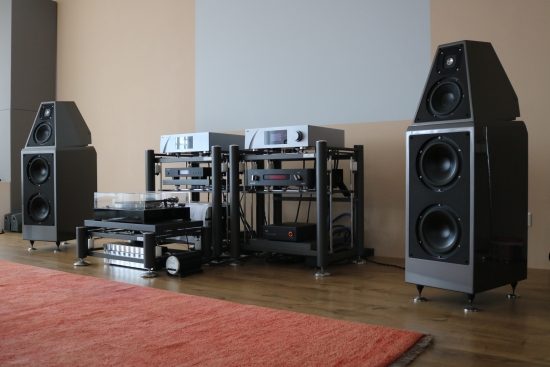
The Breakthrough
After all this, I figured that perhaps I still went about this the wrong way. I now had the feeling that my system needed to be rotated 180 degrees, with the Wilsons positioned where the Magnepans and Apogees used to be before I moved them to the other side to maximize their bass response. The Wilsons actually seemed to need the inverse treatment to linearize their bass. They did not need room-induced reinforcement. However, once the Wilsons were at the other end of the room, and my sofa at the inverse end, near the wall, an old problem returned. Rather than the enormous bass peak, there was now an enormous bass gap, I’d say at around 100 Herz. The same thing happened with the Magnepans and Apogees, which is why I obtained subs in the first place and later moved the speakers to the other side, and no longer needed the subs.
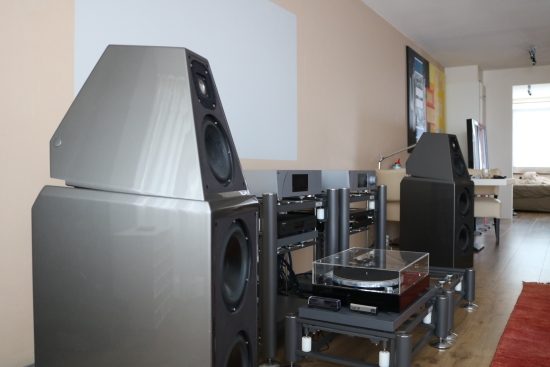
Rather than accepting the bass gaps or trying to minimize them by pulling the speakers way forward, I quickly found that Ben’s suggestion to put the speakers relatively close to the rear wall and the sofa on about two-thirds of the room yielded the best results. Having the listening position in the middle of the room induces the least resonances, but also takes away the support in the bass that many people actually like, myself included. Placing the speakers closer to the rear walls, however, nicely compensates for this.
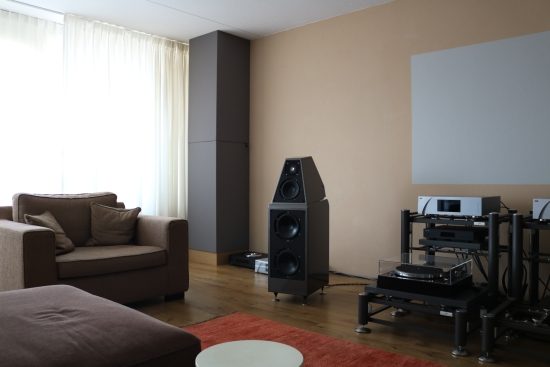
Two stacked Big Blocks in the left corner. This is the most important position in this setup. If left untreated then there is a very annoying bass reverb coming from the left that destroys the bass precision.
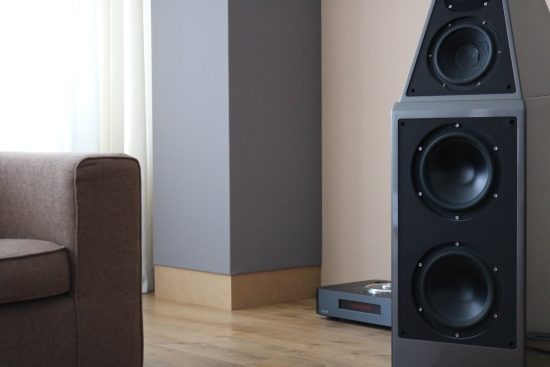
Alas, the Blocks could not be manufactured in the required 260cm length. The tallest size per block is 123cm. A filler block was possible to reach the required height but not with its own sock. I’d have to use one overall sock covering all three pieces meaning that the blocks could not be used separately, which, I’m sure I will want to do sooner or later. So, I resorted to making a pedestal myself out of MDF. Now they are nicely snug against the ceiling.
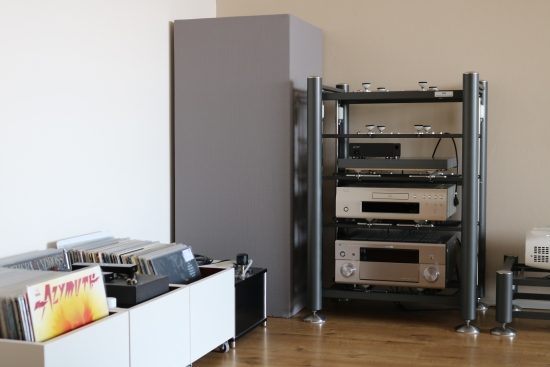
A single Big Block in the left rear corner. There’s another in the right rear corner. The Artesania rack is overkill for the surround system but with the change to the CH components I just no longer need the space in the main system. And, of course, I might change my mind again so it’s better to hold on to it just in case…
It took some experimenting with the positions of the Big Blocks, but they are very light and easy to place, and so I found 3 corners that needed to be treated. Never before have I been able to place dynamic speakers so close to the wall without this ending up in a boomy bass. Now, however, I finally had a tight and articulate bass with very good depth and no boominess whatsoever.
Speaker- and listening seat positioning remain the most important matters, but you can’t achieve greatness without careful treatment of the room. In my new setup, I now have incredible focus and transparency to rival the best I’ve heard from the best Apogees, along with truly excellent bass.
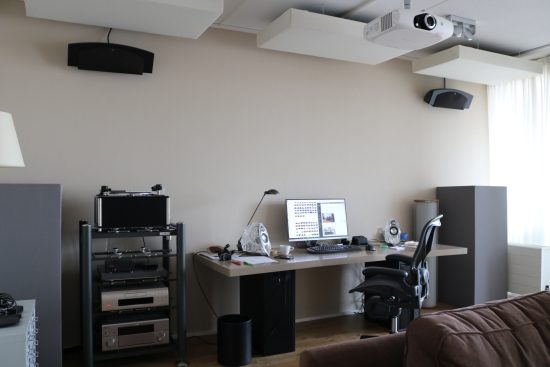
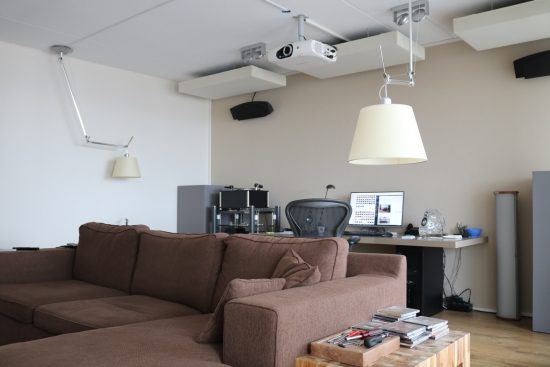
The GiK bass traps on the ceiling are not for improving the bass response of the main system but that of the Harman Kardon speakers on the desk as well as to take away any hollowness that would exist without them when speaking with other people in the room.
Read the AcousticMatters review
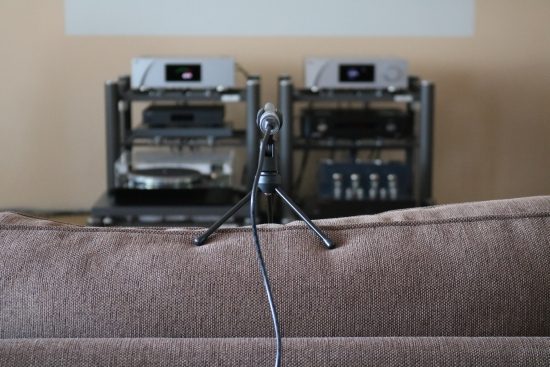
Home Audio Fidelity digital correction
Just when I thought I was done, I was approached by Thierry of Home Audio Fidelity, asking if I wanted to try his bespoke Convolution filters made using unique correction techniques to correct Room- and Loudspeaker deviations and at the same time reduce crosstalk between the speakers.
After loading the first Baseline Convolution filter, which addresses room issues, it was immediately clear that the benefits outweighed the downsides. In fact, with the filter enabled and switching the DSP engine on and off, I had a clear preference for the adjusted sound. Not only because of the beneficial correction but, surprisingly, also in terms of PRAT. When switching back to the uncorrected, non-DSP mode, the sound appeared slower and a bit indistinct by comparison. So, not only do the filters provide a more linear sound with clearer, more articulate and more accurate bass, the pacing is also improved, beyond what can be achieved without DSP!
But that was only the baseline filter. The bespoke Crosstalk Reduction filters went one step further and injected my carefully set up system in this acoustically optimized room with even more remarkable soundstaging capabilities and a superbly entertaining sense of presence and life and with nearly every music genre.
The only downside is that this does not work with Melco and so I can only use the Roon-Ready Antipodes EX music server to get the benefits from these filters. I’ve not yet done a shoot-out between the Melco sans filters and the Antipodes with them, but the fact of the matter is that both sound fabulous.
Read the Home Audio Fidelity review
Am I done now?
It’s hard to imagine but after an endless period of swapping components and tweaking them, it seems that I have arrived at what seems to be the perfect system for me. With the last Acoustics perfections in place, I have been marveling in the sound each and every time I switched on the system, for the last couple of months, with zero reservations and the Home Audio Fidelity corrections only further substantiated my pleasure.
Analog and Tubes
With the CH Precision components, I have finally found precisely the sound that I wanted. It’s quite abstract to switch on the system time and time again and being amazed at how good it sounds every single time. Digital now fully satisfies me and I have a sneaking suspicion that this system won’t be changing any time soon.
Nevertheless, analog and tubes retain a special place in my heart.
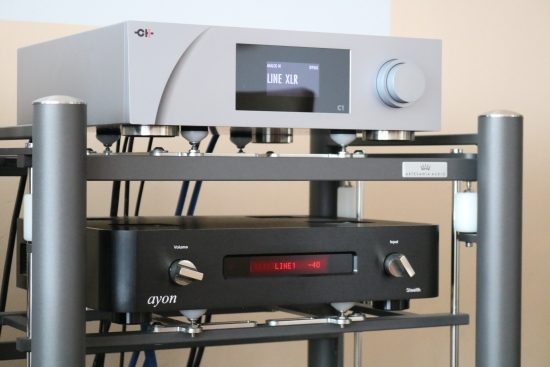
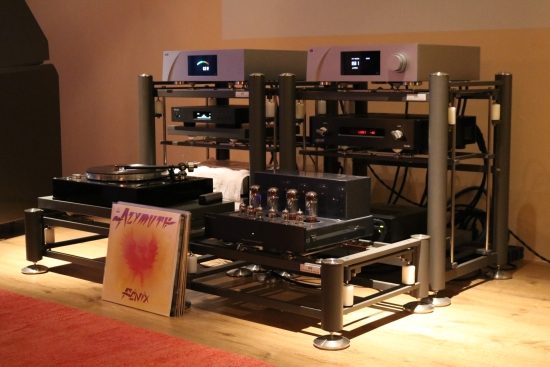
Because the CH Precision C1 is a digital component, I don’t want to route analog LP signals through it. Thanks to its analog inputs this is possible and in spite of AD’ing and DA’ing it sounds very good indeed but I prefer to retain the analog path.
That’s where the Ayon Stealth preamp/DAC comes in. This unit is sort of the reverse of the CH C1: rather than a DAC with analog inputs, it is an analog preamp with a DAC onboard. Also, it is a tube preamp and I found that it works marvelously together with the PrimaLuna DiaLogue Premium tube power amp when fed from the refurbished Thorens TD160B turntable with Origin Live tonearm and Denon DL304 cartridge. The phono stage, for now, is the Benz Lukaschek, not visible in the pictures. On the want list is a better stage, but I don’t know yet which one.
CH Precision also has a phono preamp I hear you say? Indeed they do: the P1, designed by Raphael Pasche. I can’t imagine it being any less than spectacular but then I would also need a CH Precision analog preamp. And a better turntable. And a second mortgage.
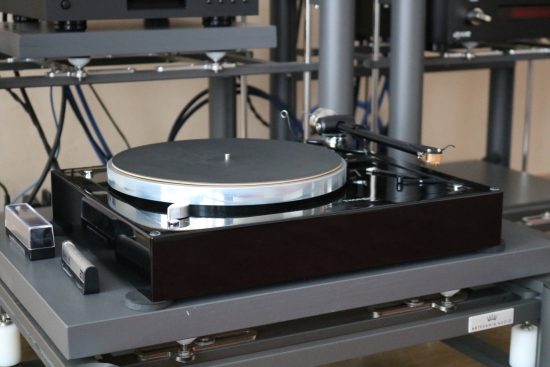
Every now and then when I am in the mood, friends and I gather, bringing a collection of vinyl, I swap the speaker cables and we have a fun evening. Neither the PrimaLuna nor the Ayon has anywhere near the transparency, fluidity, or delicacy that the CH components are so capable of but still, they can sound highly involving.
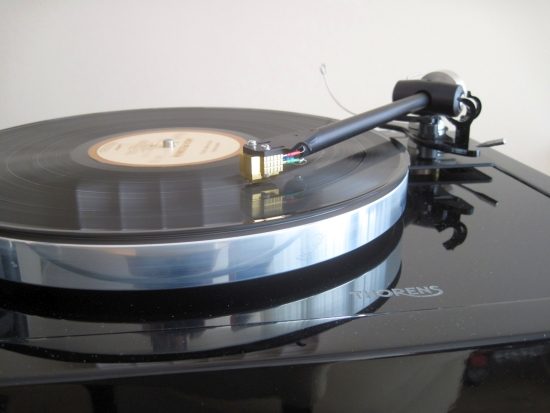
Even though the CH system is what I use most, it’s my intention to keep the tube components around so that I can carry out more comparisons related to tubes. For example, I want to compare many more tube types and many more tube amps, especially in the more affordable range. Also, I still aim to find SET amps that can drive the Wilsons and maybe come close to the sound of the VAICs. Also, I am working on finalizing the secondary system, which, for now, is based on the Corus + PSU preamp, AudioAanZee Reference Flow music server with Euphony Drive, Aqua Formula xHD DAC, Thorens TD160MKII turntable, Sw1x LPU-1 tube phono preamp, PrimaLuna DiaLogue Premium tube power amp, and Xavian Perla speakers.
Next: how beamer issues would lead to the start of a new Secondary Audio Setup / Cinema Room.
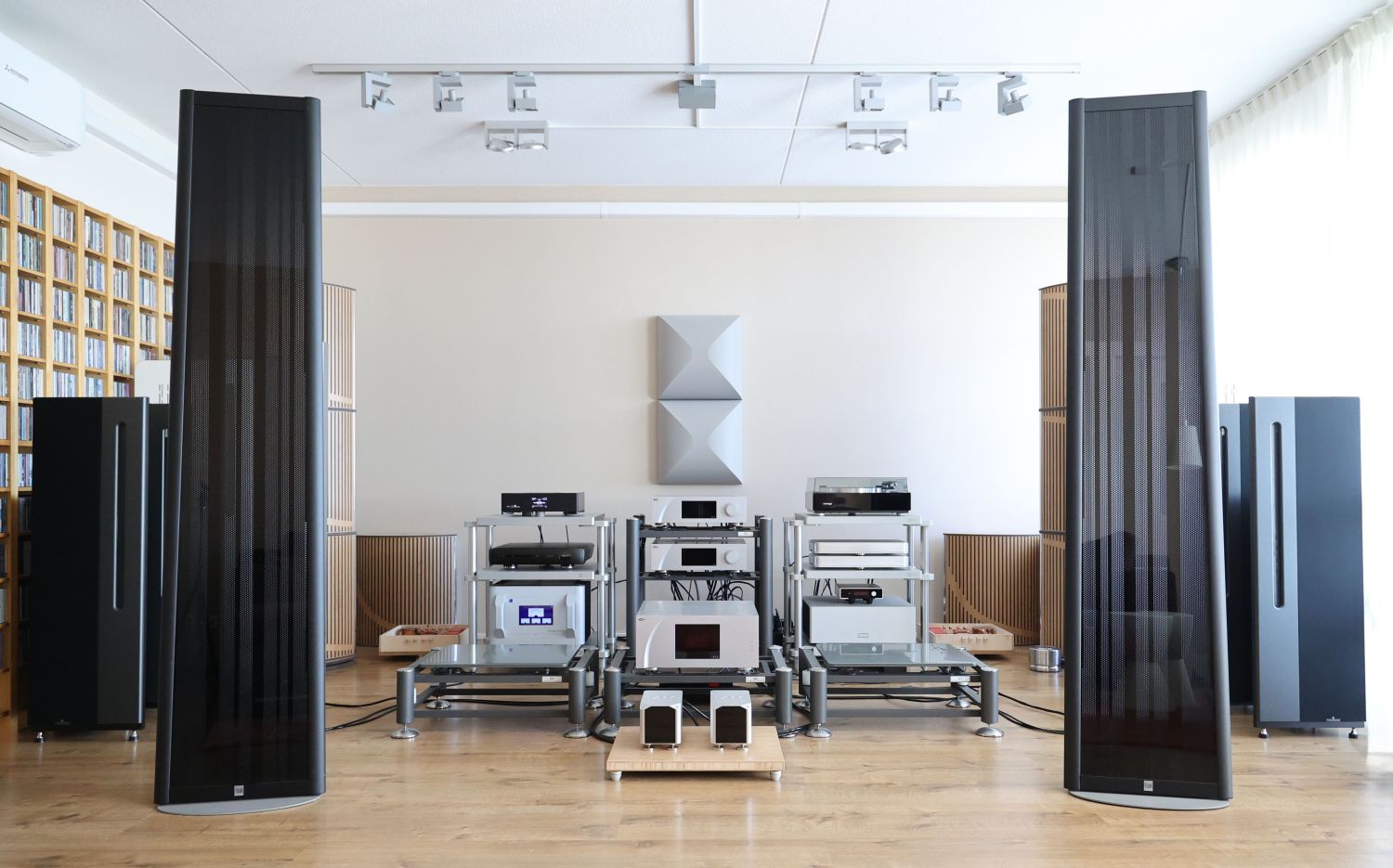
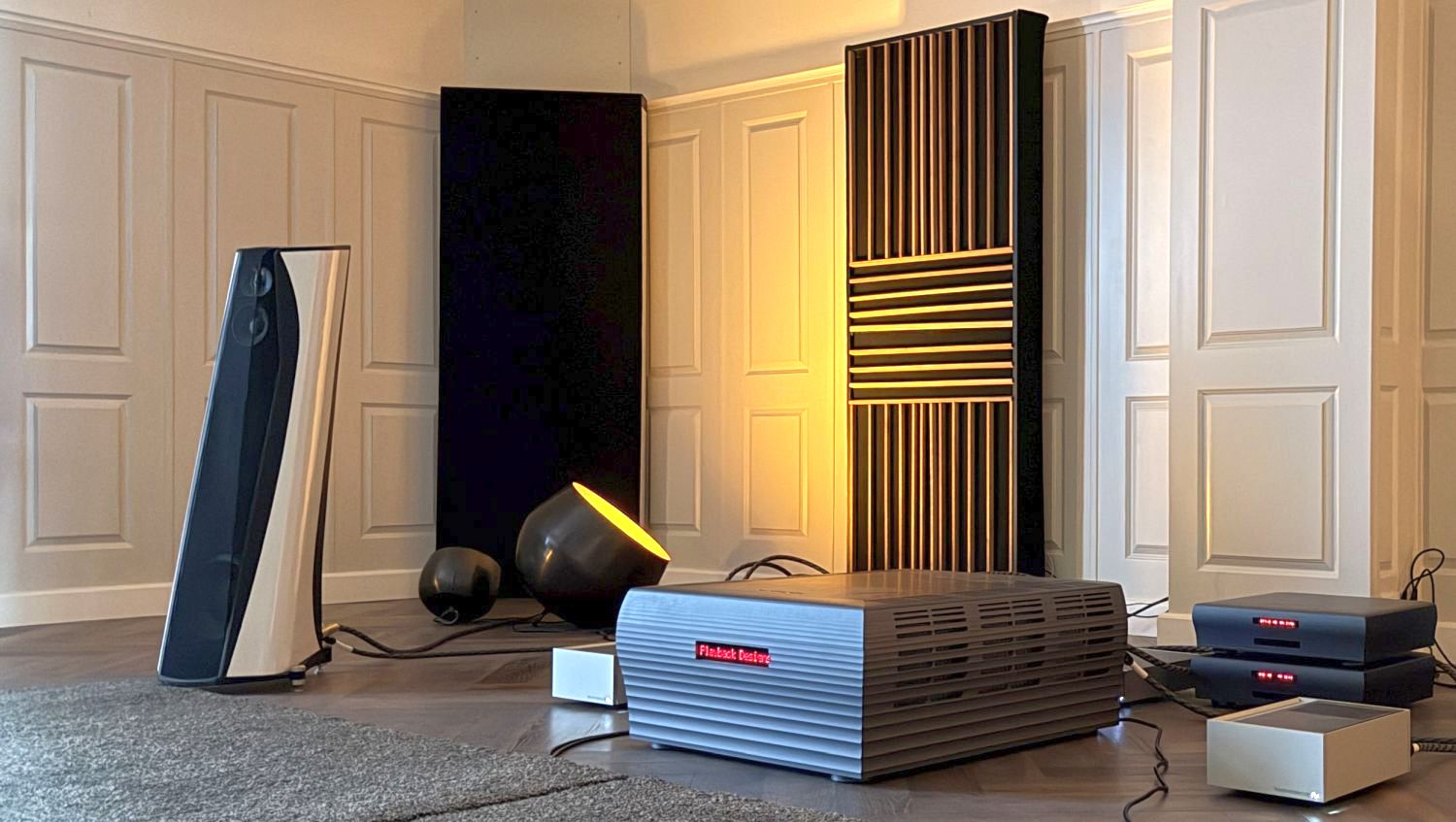
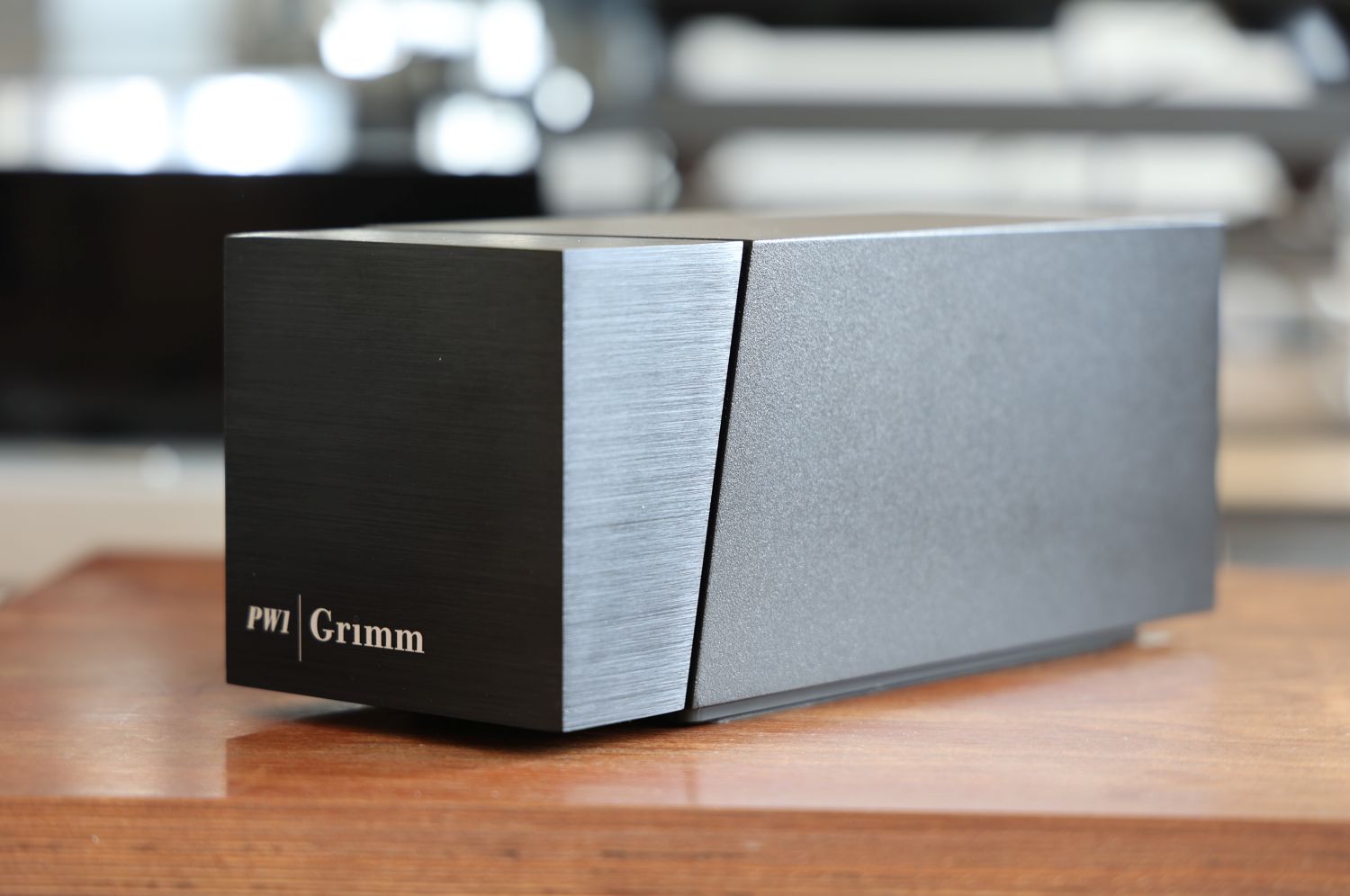

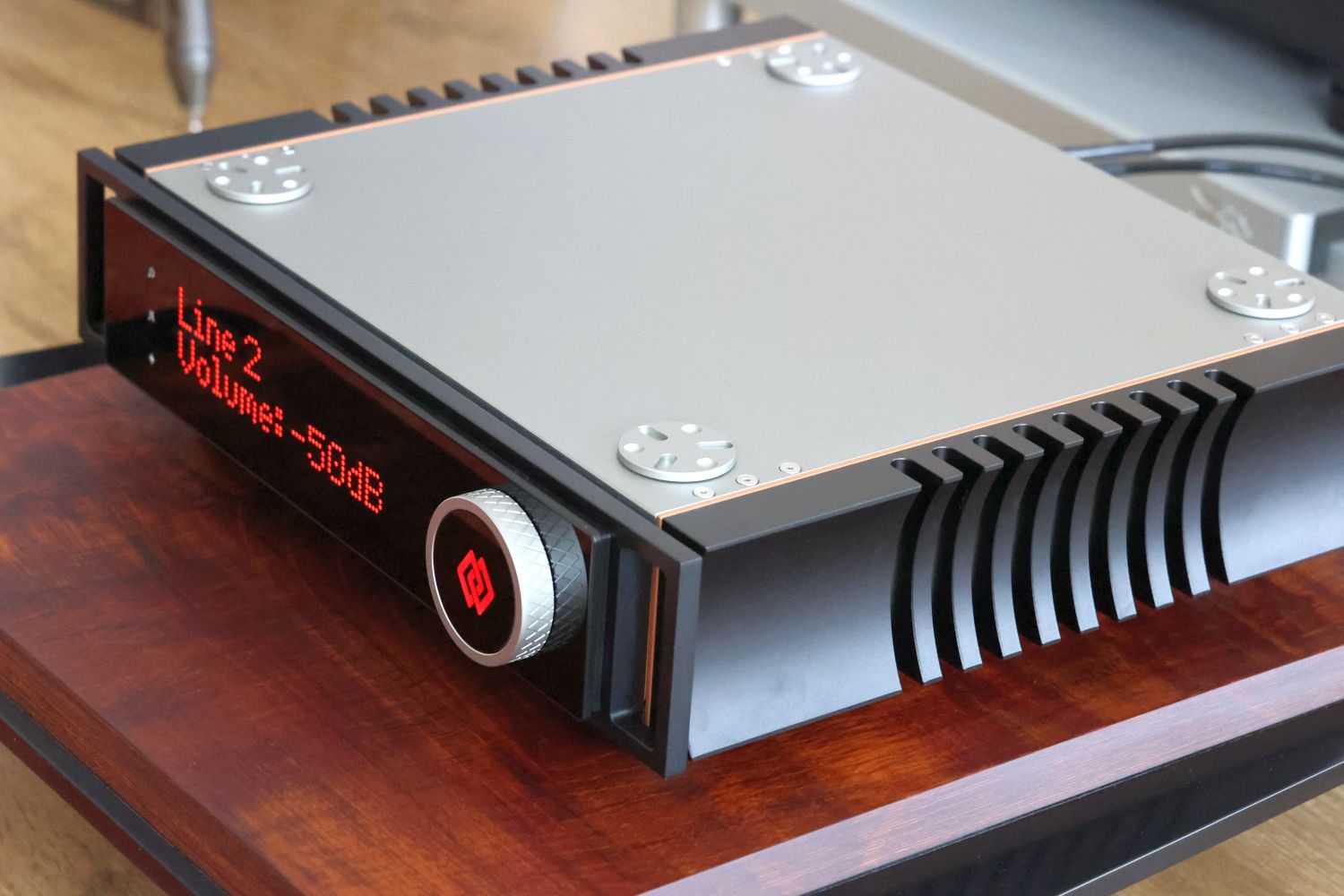
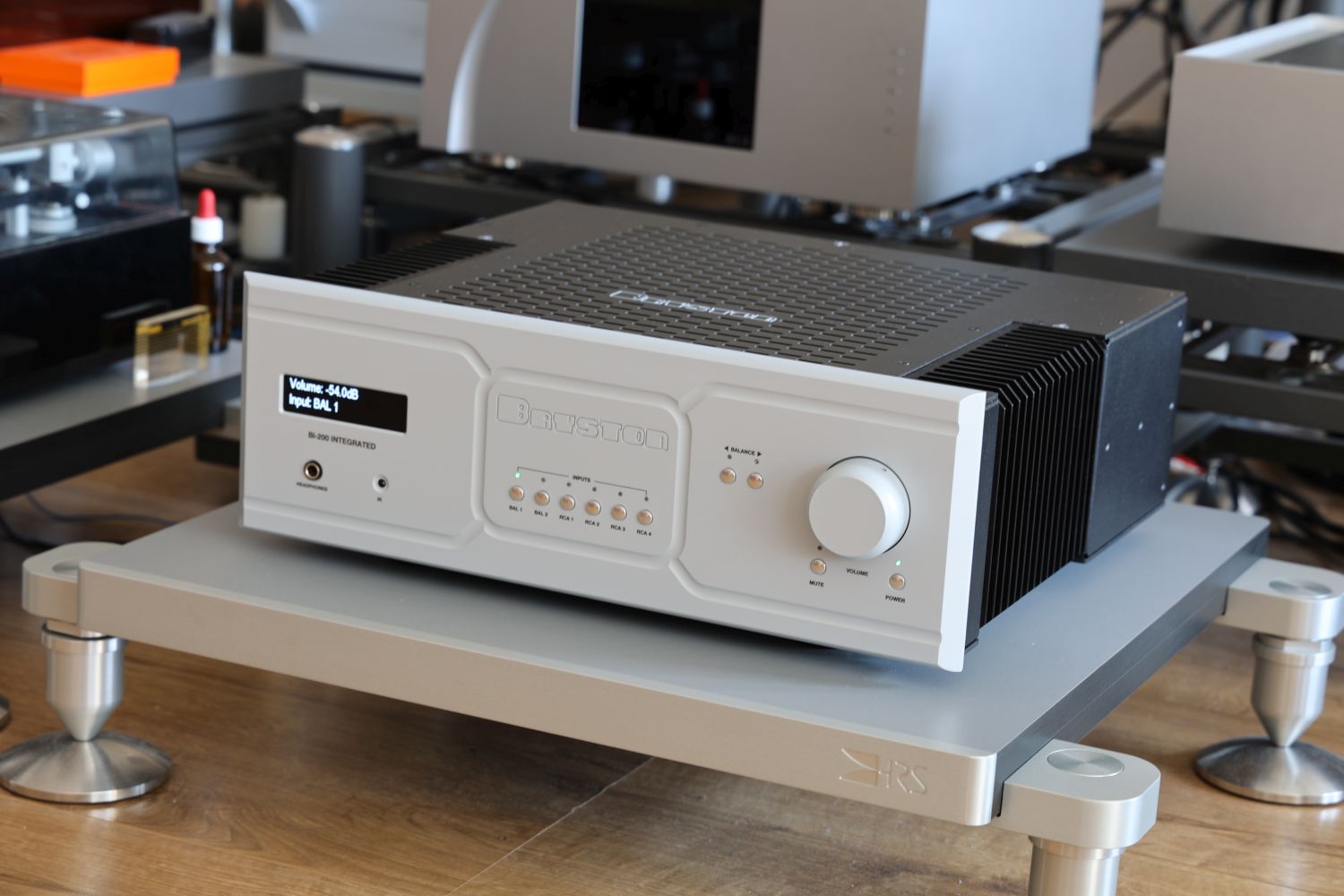
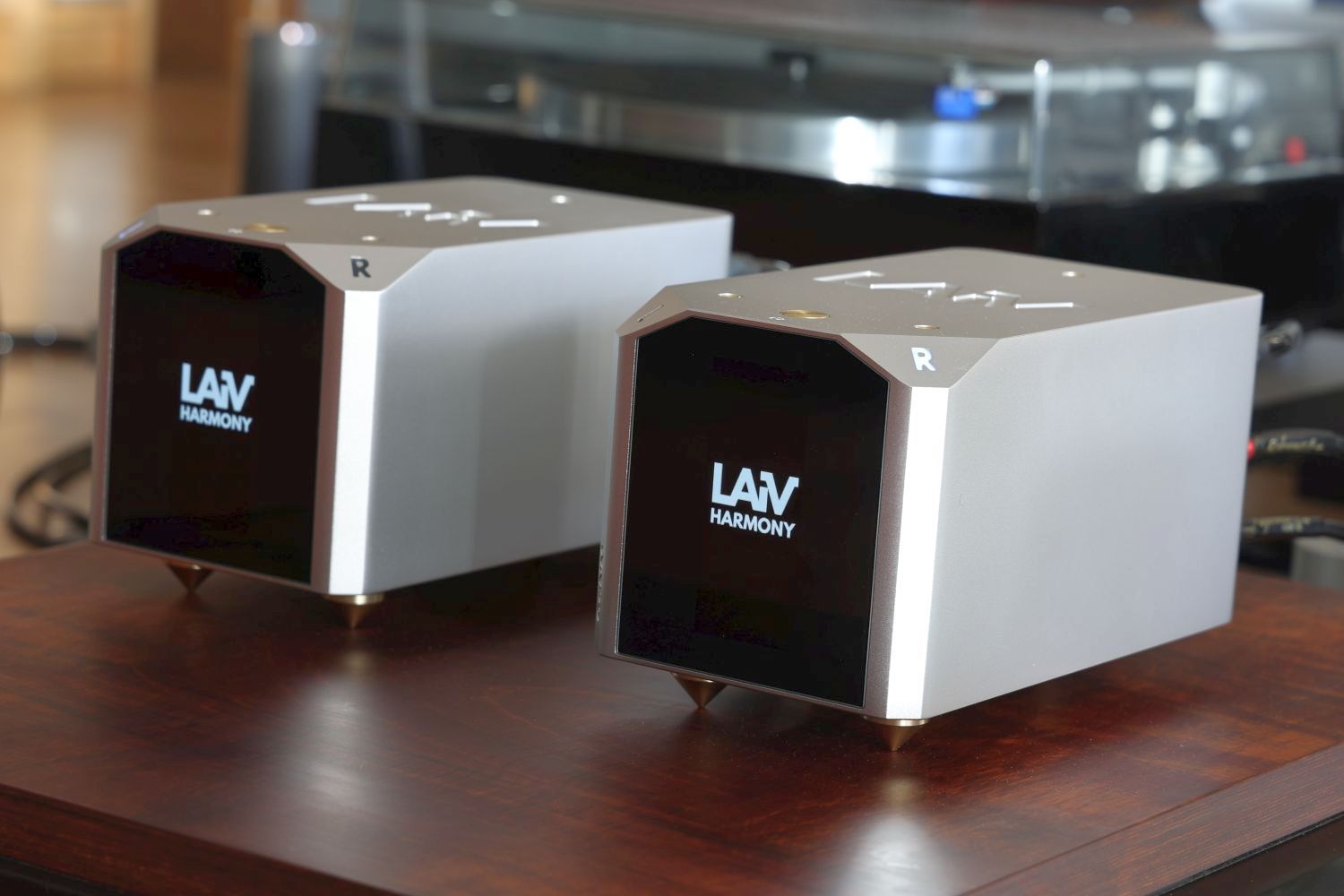
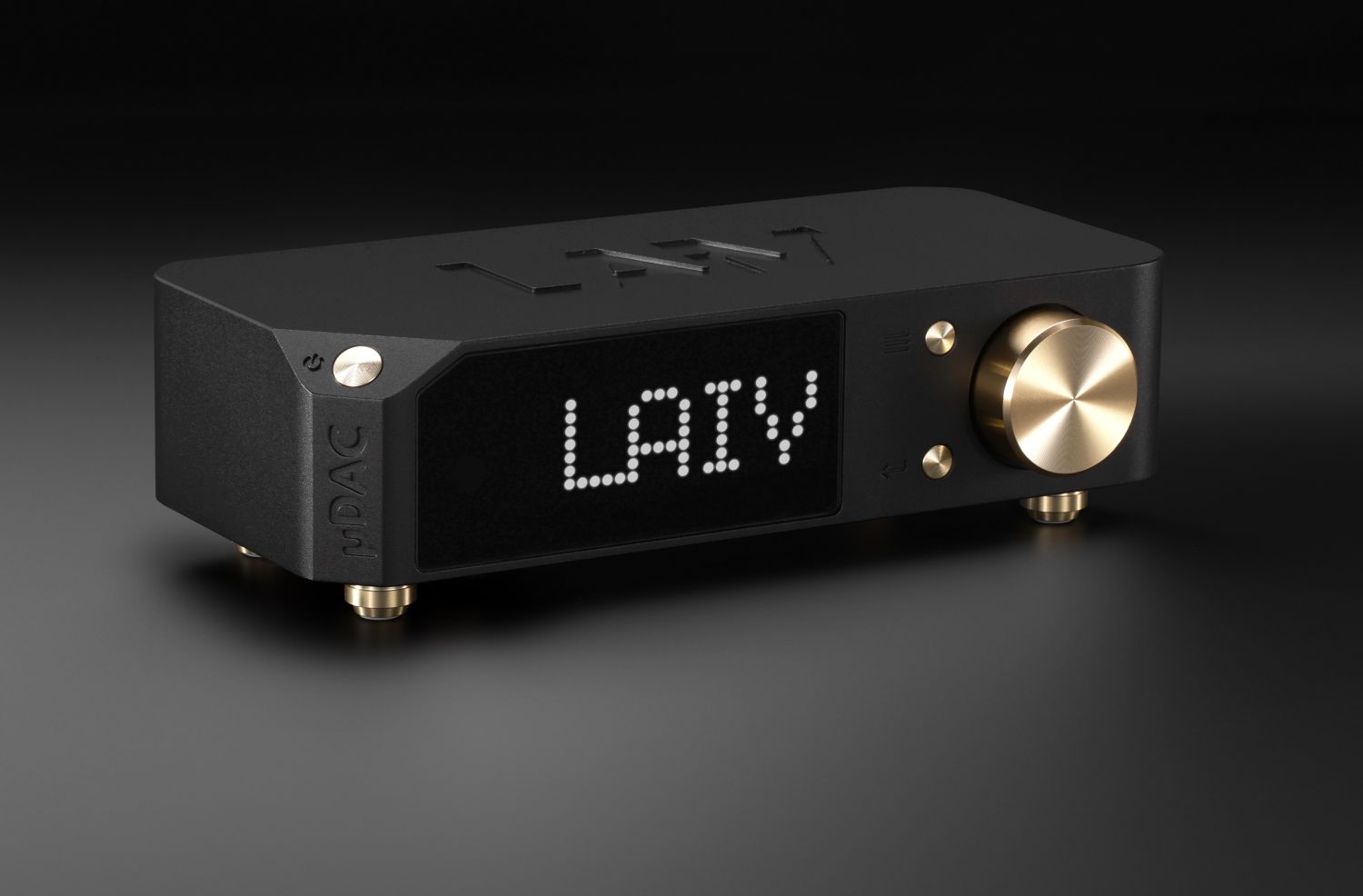
Christiaan, I’m sure your system sounds phenomenal – I would love to hear it. Congratulations, it must be such a joy to know you have the sound you’ve been striving for.
Over on my side of the world, I’m afraid things aren’t going as smoothly. I am having this weird experience with my Apogee Centaur Majors where the sound will suddenly degrade and become transistor like (like from a radio). I went to toggle the treble/bass switches on the back of the Majors and this temporarily solved the problem but now it’s intermittent. Is this likely a tube in my Quicksilver Mid-Mono amps going bad? Someone also said it could be a power problem causing this huge fluctuation in sound quality. It’s driving me nuts!
I have not heard such fluctuating issues with any Apogees, not even very old, original ones. When switches were making a bad connection, they would just not function, but never would this produce the harsh FM-like sound that you describe.
First thing I would do in your case is to try another amp to rule out anything on that side. If you’ve confirmed that the issue remains then I’d try to get in contact with one of the official Graz-approved Apogee restorers. If the issue is with the Majors then I’m sure it can be fixed. Good luck!
Thanks, Christiaan. I think your point about making proper connection is spot on. May I ask: how did you connect to the Majors when you had them in your system. Spade or banana plug?
Hi Gary, always spades. They make the sturdiest connection.
Hello Christiaan,
CH Precision components are better than JRDG ?
I readed : ‘which means that my precious Rowland Corus + PSU no longer applied’
So the question is : will you sell your Rowland products ?
Best regards
NGUYEN
I can’t say that one is strictly better than the other, it’s not black and white and both brands offer state of the art products but they sure are different. My taste has evolved and currently I do indeed prefer CH over JRDG. The Corus + PSU is for sale and can be found on audio-markt.de.
thank you very much for your honest comment.
Hi Christiaan
Is there a summary page stating what hears you are currently using? I find it a bit difficult to follow through If not reading from previous posts.
Thanks and regards,
Joey
By “hears”, you mean gears? If so, yes I used to have a summary page but because my setup kept changing, those pages were always out of date. Best to do is to read the Audio History’s latest entry, as well as a recent review for a complete picture. The latest reviews mostly have the system such as it is at any point in time. Alternatively, feel free to ask anything in the comments relating to any review and I’ll gladly respond there.
HI Christiaan, I have the Wilson Sasha and Pass Labs xa100.8 with MSB DAC. it was sheer agony taming the Sasha upper bass until I followed the manual. and….. speaker sounds best close to front wall i.e. wall behind the speaker. I have room treatment similar to yours and I was about to give up HIFI and settle on a simple lifestyle audio solution but persevere I did. big problem solved . now I am working on fine tuning.
Indeed, it’s a bit of a known issue with many Wilsons but once you get it right, they have some of the most powerful bass in the business. PS: in my case, having them relatively close to each other provided the most even-handed as well as the most solid bass. Then, of course, I am also sitting relatively close to them. Nevertheless, if you still have a bit of mid-bass boom, moving them slightly more apart (while retaining the rear wall distance) might do the trick.
Thank you Christiaan. I have 2680 mm distance between tweeters. Testing different genres . Still tweaking for a touch more definition . I’ve passed the stage of being driven crazy cos my kit now sounds pleasant.